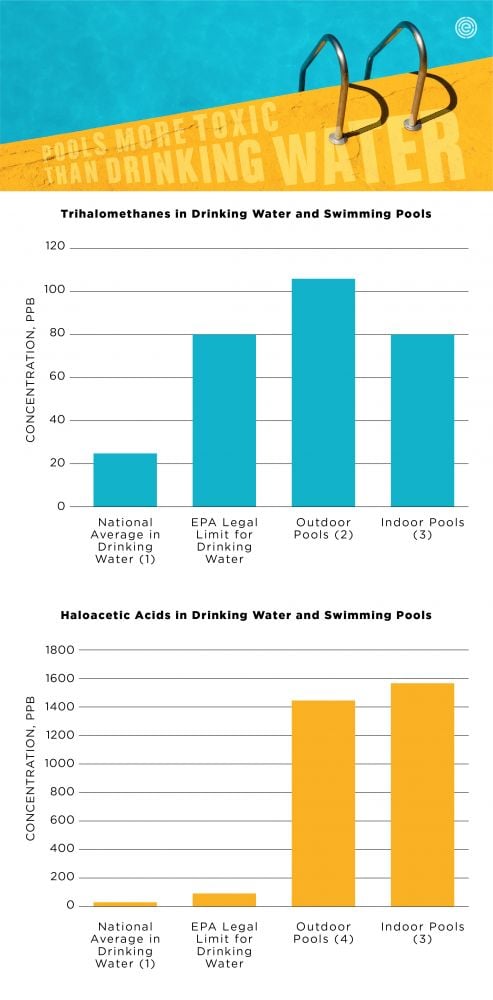
It’s no secret that pee finds its way into swimming pools. In fact, the typical residential pool contains about two gallons of urine. What’s worse, there are other, more alarming contaminants lurking in the depths, and pee in the pool could be making the problem worse.
Pools are vulnerable to all the biological and chemical contaminants swimmers bring with them: sweat, saliva, lotion, sunscreen, hair, makeup, gel, oil, skin cells, bacteria and, of course, urine. Disinfectants like chlorine are added to the water to keep it safe and free of viruses, bacteria and other pathogens.
Chlorine kills or deactivates the pathogens, but other contaminants can combine with it to form toxic disinfection byproducts, such as chloroform. Scientists have identified more than 600 different disinfection byproducts, and many have been linked to cancer and harm to the developing fetus. As with many other toxic chemicals, disinfection byproducts can pose a particular risk to children, and exposure for children is often much greater than for adults.
The Environmental Protection Agency has set a legal limit for two groups of disinfection byproducts in drinking water – 80 parts per billion, or ppb, for trihalomethanes and 60 ppb for haloacetic acids. Yet no such regulations exist for swimming pools.
In contrast to drinking water, residual chlorine and disinfection byproducts in swimming pool water cannot be completely filtered out, because filters that remove the byproducts would also remove the chlorine. The water must always contain a low level of disinfectant to ensure it is not re-contaminated with pathogens whenever anyone enters the pool.

Source: EWG, from EWG’s Tap Water Database and studies cited below
(1) EWG Tap Water Database; (2) 2007 study of 2 outdoor pools; (3) 2015 study of 23 indoor pools; (4) 2014 study of 6 outdoor pools in Pennsylvania
Pools are rarely emptied and refilled, and the regular addition of chlorine and contaminants from swimmers results in a continuous buildup of disinfection byproducts. Some can be reduced by the addition of other chemicals, broken up by sunlight, or released into the air. Even after the pool water is filtered, as it is recirculated over months or years, contaminants accumulate.
Dozens of studies on indoor swimming pools have found often alarmingly high levels of disinfection byproducts. In one study of 23 indoor pools, researchers reported that haloacetic acids were found at an average concentration of 1,541 ppb, more than 25 times the level the EPA allows in drinking water. At this level, accidentally swallowing a third of a cup of pool water – what a child ingests in just an hour and a half – would exceed the maximum daily legal dose established by the EPA for drinking water.
In addition to the risks of accidentally swallowing water with disinfection byproducts, these chemicals can be also inhaled from poolside air or absorbed through the skin. Swimmers who are children or teenagers have an increased risk of developing bronchial hyperreactivity, asthma and rhinitis because of exposure to disinfection byproducts from pools.
To decrease disinfection byproduct levels, a number of chlorine alternatives have been explored, but with little success. A common misconception is that salt pools are free from chlorine, but that’s not so. Chlorine is generated from the salt after it passes through a salt-chlorine generator, so salt pools also have chlorine-related disinfection byproducts.
Some pools may use bromine, a chemical disinfectant similar to chlorine. However, scientists from the University of South Carolina reported in 2016 that pools using bromine as a disinfectant still carried high concentrations of disinfection byproducts, and some of these byproducts were more toxic than chlorine-based byproducts.
Disinfection methods such as ultraviolet light and ozone can decrease the level of certain byproducts but increase the level of others. Some companies have started marketing copper-silver ionization technologies in place of, or along with, chlorine for pool disinfection. More research is needed to assess the safety and effectiveness of this approach.
Part of the problem may be using too much chlorine. High levels of residual chlorine may contribute to high levels of disinfection byproducts. The minimum level of chlorine required in public pools and spas in the U.S. is higher than in many other countries. Using the minimum amount of chlorine necessary to disinfect the pool may help keep disinfection byproduct levels low, but will not eliminate them altogether.
There is no need to boycott your neighborhood pool. The major source of disinfection byproducts in pool water – “human input” – is also part of the solution. The key is to keep contaminants like lotions, body oils and urine out of the pool in the first place.
In an experimental study published in 2014, disinfection byproduct formation was reduced by more than two-thirds when swimmers used the bathroom to relieve themselves and showered for just 60 seconds before they got in the pool.
Reducing these contaminants could also help maintain good pool chemistry. Pool owners may find it easier to keep pool chemicals at acceptable levels when there are fewer contaminants using up chlorine, clouding up the water and shifting the pH balance.
Of course, when the sun is shining, it is important to wear sunscreen – or even, better seek shade. Swimmers should always apply and re-apply sunscreen when swimming outdoors. Sunscreen works best when applied early and often, so slather it on after each rinse and during every bathroom break. Use EWG’s Guide to Sunscreens to find safer sun-protective products.
For tips on how to get a cleaner pool experience, check out EWG’s Guide to Reducing Disinfectant Byproducts in Pools.



